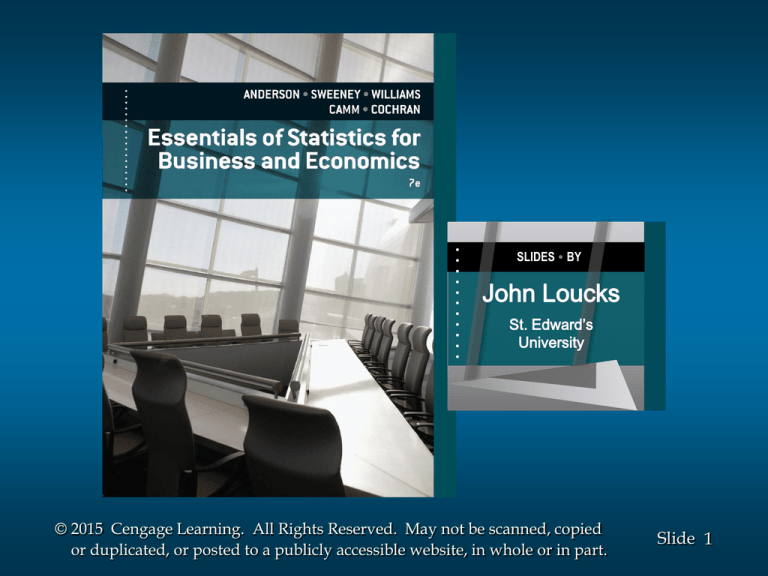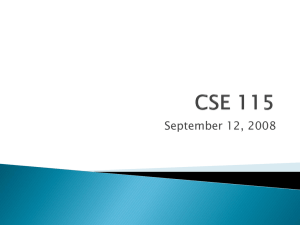
..
.
..
.
..
.
..
.
SLIDES BY
John Loucks
St. Edward’s
University
© 2015 Cengage Learning. All Rights Reserved. May not be scanned, copied
or duplicated, or posted to a publicly accessible website, in whole or in part.
Slide 1
Chapter 11
Comparisons Involving Proportions
and a Test of Independence
Inferences About the Difference Between
Two Population Proportions
Testing the Equality of Population Proportions
for Three or More Populations
Test of Independence
© 2015 Cengage Learning. All Rights Reserved. May not be scanned, copied
or duplicated, or posted to a publicly accessible website, in whole or in part.
Slide 2
Inferences About the Difference Between
Two Population Proportions
Interval Estimation of p1 - p2
Hypothesis Tests About p1 - p2
© 2015 Cengage Learning. All Rights Reserved. May not be scanned, copied
or duplicated, or posted to a publicly accessible website, in whole or in part.
Slide 3
Sampling Distribution of p1 p2
Expected Value
E ( p1 p2 ) p1 p2
Standard Deviation (Standard Error)
p1 p2
p1 (1 p1 ) p2 (1 p2 )
n1
n2
where: n1 = size of sample taken from population 1
n2 = size of sample taken from population 2
© 2015 Cengage Learning. All Rights Reserved. May not be scanned, copied
or duplicated, or posted to a publicly accessible website, in whole or in part.
Slide 4
Sampling Distribution of p1 p2
If the sample sizes are large, the sampling distribution
of p1 p2 can be approximated by a normal probability
distribution.
The sample sizes are sufficiently large if all of these
conditions are met:
n1p1 > 5
n1(1 - p1) > 5
n2p2 > 5
n2(1 - p2) > 5
© 2015 Cengage Learning. All Rights Reserved. May not be scanned, copied
or duplicated, or posted to a publicly accessible website, in whole or in part.
Slide 5
Sampling Distribution of p1 p2
p1 p2
p1 (1 p1 ) p2 (1 p2 )
n1
n2
p1 p2
p1 – p2
© 2015 Cengage Learning. All Rights Reserved. May not be scanned, copied
or duplicated, or posted to a publicly accessible website, in whole or in part.
Slide 6
Interval Estimation of p1 - p2
Interval Estimate
p1 p2 z / 2
p1 (1 p1 ) p2 (1 p2 )
n1
n2
© 2015 Cengage Learning. All Rights Reserved. May not be scanned, copied
or duplicated, or posted to a publicly accessible website, in whole or in part.
Slide 7
Interval Estimation of p1 - p2
Example: Market Research Associates
Market Research Associates is conducting research
to evaluate the effectiveness of a client’s new advertising campaign. Before the new campaign began, a
telephone survey of 150 households in the test market
area showed 60 households “aware” of the client’s
product.
The new campaign has been initiated with TV and
newspaper advertisements running for three weeks.
© 2015 Cengage Learning. All Rights Reserved. May not be scanned, copied
or duplicated, or posted to a publicly accessible website, in whole or in part.
Slide 8
Interval Estimation of p1 - p2
Example: Market Research Associates
A survey conducted immediately after the new
campaign showed 120 of 250 households “aware” of
the client’s product.
Does the data support the position that the
advertising campaign has provided an increased
awareness of the client’s product?
© 2015 Cengage Learning. All Rights Reserved. May not be scanned, copied
or duplicated, or posted to a publicly accessible website, in whole or in part.
Slide 9
Point Estimator of the Difference Between
Two Population Proportions
p1 = proportion of the population of households
“aware” of the product after the new campaign
p2 = proportion of the population of households
“aware” of the product before the new campaign
p1 = sample proportion of households “aware” of the
product after the new campaign
p2 = sample proportion of households “aware” of the
product before the new campaign
120 60
p1 p2
.48 .40 .08
250 150
© 2015 Cengage Learning. All Rights Reserved. May not be scanned, copied
or duplicated, or posted to a publicly accessible website, in whole or in part.
Slide 10
Interval Estimation of p1 - p2
For = .05, z.025 = 1.96:
.48(.52) .40(.60)
.48 .40 1.96
250
150
.08 + 1.96(.0510)
.08 + .10
Hence, the 95% confidence interval for the difference
in before and after awareness of the product is
-.02 to +.18.
© 2015 Cengage Learning. All Rights Reserved. May not be scanned, copied
or duplicated, or posted to a publicly accessible website, in whole or in part.
Slide 11
Hypothesis Tests about p1 - p2
Hypotheses
We focus on tests involving no difference between
the two population proportions (i.e. p1 = p2)
H 0 : p1 p2 0
H a : p1 p2 0
Left-tailed
H
H00::
H
Ha::
a
pp1
- p2 < 0
1 p2 0
pp1
- pp2 > 00
1
2
Right-tailed
H 0 : p1 p2 0
H a : p1 p2 0
Two-tailed
© 2015 Cengage Learning. All Rights Reserved. May not be scanned, copied
or duplicated, or posted to a publicly accessible website, in whole or in part.
Slide 12
Hypothesis Tests about p1 - p2
Standard Error of p1 p2 when p1 = p2 = p
p1 p2
1 1
p(1 p)
n1 n2
Pooled Estimator of p when p1 = p2 = p
n1 p1 n2 p2
p
n1 n2
© 2015 Cengage Learning. All Rights Reserved. May not be scanned, copied
or duplicated, or posted to a publicly accessible website, in whole or in part.
Slide 13
Hypothesis Tests about p1 - p2
Test Statistic
z
( p1 p2 )
1
1
p(1 p )
n
n
2
1
© 2015 Cengage Learning. All Rights Reserved. May not be scanned, copied
or duplicated, or posted to a publicly accessible website, in whole or in part.
Slide 14
Hypothesis Tests about p1 - p2
Example: Market Research Associates
Can we conclude, using a .05 level of significance,
that the proportion of households aware of the
client’s product increased after the new advertising
campaign?
© 2015 Cengage Learning. All Rights Reserved. May not be scanned, copied
or duplicated, or posted to a publicly accessible website, in whole or in part.
Slide 15
Hypothesis Tests about p1 - p2
p -Value and Critical Value Approaches
1. Develop the hypotheses.
H0: p1 - p2 < 0
Ha: p1 - p2 > 0
p1 = proportion of the population of households
“aware” of the product after the new campaign
p2 = proportion of the population of households
“aware” of the product before the new campaign
© 2015 Cengage Learning. All Rights Reserved. May not be scanned, copied
or duplicated, or posted to a publicly accessible website, in whole or in part.
Slide 16
Hypothesis Tests about p1 - p2
p -Value and Critical Value Approaches
2. Specify the level of significance.
= .05
3. Compute the value of the test statistic.
250(. 48) 150(. 40) 180
p
. 45
250 150
400
s p1 p2 . 45(. 55)( 1
z
1 ) . 0514
250 150
(.48 .40) 0
.08
1.56
.0514
.0514
© 2015 Cengage Learning. All Rights Reserved. May not be scanned, copied
or duplicated, or posted to a publicly accessible website, in whole or in part.
Slide 17
Hypothesis Tests about p1 - p2
p –Value Approach
4. Compute the p –value.
For z = 1.56, the p–value = .0594
5. Determine whether to reject H0.
Because p–value > = .05, we cannot reject H0.
We cannot conclude that the proportion of households
aware of the client’s product increased after the new
campaign.
© 2015 Cengage Learning. All Rights Reserved. May not be scanned, copied
or duplicated, or posted to a publicly accessible website, in whole or in part.
Slide 18
Hypothesis Tests about p1 - p2
Critical Value Approach
4. Determine the critical value and rejection rule.
For = .05, z.05 = 1.645
Reject H0 if z > 1.645
5. Determine whether to reject H0.
Because 1.56 < 1.645, we cannot reject H0.
We cannot conclude that the proportion of households
aware of the client’s product increased after the new
campaign.
© 2015 Cengage Learning. All Rights Reserved. May not be scanned, copied
or duplicated, or posted to a publicly accessible website, in whole or in part.
Slide 19
Testing the Equality of Population Proportions
for Three or More Populations
Using the notation
p1 = population proportion for population 1
p2 = population proportion for population 2
and pk = population proportion for population k
The hypotheses for the equality of population
proportions for k > 3 populations are as follows:
H0: p1 = p2 =
. . .
= pk
Ha: Not all population proportions are equal
© 2015 Cengage Learning. All Rights Reserved. May not be scanned, copied
or duplicated, or posted to a publicly accessible website, in whole or in part.
Slide 20
Testing the Equality of Population Proportions
for Three or More Populations
If H0 cannot be rejected, we cannot detect a
difference among the k population proportions.
If H0 can be rejected, we can conclude that not all k
population proportions are equal.
Further analyses can be done to conclude which
population proportions are significantly different
from others.
© 2015 Cengage Learning. All Rights Reserved. May not be scanned, copied
or duplicated, or posted to a publicly accessible website, in whole or in part.
Slide 21
Testing the Equality of Population Proportions
for Three or More Populations
Example: Finger Lakes Homes
Finger Lakes Homes manufactures three models of
prefabricated homes: a two-story colonial, a log cabin,
and an A-frame. To help in product-line planning,
management would like to compare the customer
satisfaction with the three home styles.
p1 = proportion likely to repurchase a Colonial
for the population of Colonial owners
p2 = proportion likely to repurchase a Log Cabin
for the population of Log Cabin owners
p3 = proportion likely to repurchase an A-Frame
for the population of A-Frame owners
© 2015 Cengage Learning. All Rights Reserved. May not be scanned, copied
or duplicated, or posted to a publicly accessible website, in whole or in part.
Slide 22
Testing the Equality of Population Proportions
for Three or More Populations
We begin by taking a sample of owners from each of
the three populations.
Each sample contains categorical data indicating
whether the respondents are likely or not likely to
repurchase the home.
© 2015 Cengage Learning. All Rights Reserved. May not be scanned, copied
or duplicated, or posted to a publicly accessible website, in whole or in part.
Slide 23
Testing the Equality of Population Proportions
for Three or More Populations
Observed Frequencies (sample results)
Home Owner
Colonial Log A-Frame
Likely to
Yes
100
81
83
Repurchase No
35
20
41
Total
135
101
124
© 2015 Cengage Learning. All Rights Reserved. May not be scanned, copied
or duplicated, or posted to a publicly accessible website, in whole or in part.
Total
264
96
360
Slide 24
Testing the Equality of Population Proportions
for Three or More Populations
Next, we determine the expected frequencies under
the assumption H0 is correct.
Expected Frequencies
Under the Assumption H0 is True
eij
(Row i Total)(Column j Total)
Total Sample Size
If a significant difference exists between the observed
and expected frequencies, H0 can be rejected.
© 2015 Cengage Learning. All Rights Reserved. May not be scanned, copied
or duplicated, or posted to a publicly accessible website, in whole or in part.
Slide 25
Testing the Equality of Population Proportions
for Three or More Populations
Expected Frequencies (computed)
Home Owner
Colonial Log A-Frame
Likely to
Yes
99.00 74.07 90.93
Repurchase No
36.00 26.93 33.07
Total
135
101
124
© 2015 Cengage Learning. All Rights Reserved. May not be scanned, copied
or duplicated, or posted to a publicly accessible website, in whole or in part.
Total
264
96
360
Slide 26
Testing the Equality of Population Proportions
for Three or More Populations
Next, compute the value of the chi-square test statistic.
2
i
j
( f ij eij )2
eij
where:
fij = observed frequency for the cell in row i and column j
eij = expected frequency for the cell in row i and column j
under the assumption H0 is true
Note: The test statistic has a chi-square distribution with
k – 1 degrees of freedom, provided the expected
frequency is 5 or more for each cell.
© 2015 Cengage Learning. All Rights Reserved. May not be scanned, copied
or duplicated, or posted to a publicly accessible website, in whole or in part.
Slide 27
Testing the Equality of Population Proportions
for Three or More Populations
Computation of the Chi-Square Test Statistic.
Obs.
Exp.
Sqd.
Sqd. Diff. /
Likely to
Home
Freq.
Freq.
Diff.
Diff.
Exp. Freq.
Repurch.
Owner
fij
eij
(fij - eij)
(fij - eij)2
(fij - eij)2/eij
Yes
Colonial
97
97.50
-0.50
0.2500
0.0026
Yes
Log Cab.
83
72.94
10.06
101.1142
1.3862
Yes
A-Frame
80
89.56
-9.56
91.3086
1.0196
No
Colonial
38
37.50
0.50
0.2500
0.0067
No
Log Cab.
18
28.06
-10.06
101.1142
3.6041
No
A-Frame
44
34.44
9.56
91.3086
2.6509
Total
360
360
2 =
© 2015 Cengage Learning. All Rights Reserved. May not be scanned, copied
or duplicated, or posted to a publicly accessible website, in whole or in part.
8.6700
Slide 28
Testing the Equality of Population Proportions
for Three or More Populations
Rejection Rule
p-value approach:
Reject H0 if p-value <
Critical value approach:
Reject H0 if 2 2
where is the significance level and
there are k - 1 degrees of freedom
© 2015 Cengage Learning. All Rights Reserved. May not be scanned, copied
or duplicated, or posted to a publicly accessible website, in whole or in part.
Slide 29
Testing the Equality of Population Proportions
for Three or More Populations
Rejection Rule (using = .05)
Reject H0 if p-value < .05 or 2 > 5.991
With = .05 and
k-1=3-1=2
degrees of freedom
Do Not Reject H0
Reject H0
5.991
© 2015 Cengage Learning. All Rights Reserved. May not be scanned, copied
or duplicated, or posted to a publicly accessible website, in whole or in part.
2
Slide 30
Testing the Equality of Population Proportions
for Three or More Populations
Conclusion Using the p-Value Approach
Area in Upper Tail
.10
.05
2 Value (df = 2)
4.605 5.991
.025
7.378
.01
.005
9.210 10.597
Because 2 = 8.670 is between 9.210 and 7.378, the
area in the upper tail of the distribution is between
.01 and .025.
The p-value < . We can reject the null hypothesis.
Actual p-value is .0131
© 2015 Cengage Learning. All Rights Reserved. May not be scanned, copied
or duplicated, or posted to a publicly accessible website, in whole or in part.
Slide 31
Testing the Equality of Population Proportions
for Three or More Populations
We have concluded that the population proportions
for the three populations of home owners are not
equal.
To identify where the differences between
population proportions exist, we will rely on a
multiple comparisons procedure.
© 2015 Cengage Learning. All Rights Reserved. May not be scanned, copied
or duplicated, or posted to a publicly accessible website, in whole or in part.
Slide 32
Multiple Comparisons Procedure
We begin by computing the three sample proportions.
Colonial: p1 100
.741
135
Log Cabin: p2 81
.802
101
A-Frame: p3 83
124
.669
We will use a multiple comparison procedure known
as the Marascuillo procedure.
© 2015 Cengage Learning. All Rights Reserved. May not be scanned, copied
or duplicated, or posted to a publicly accessible website, in whole or in part.
Slide 33
Multiple Comparisons Procedure
Marascuillo Procedure
We compute the absolute value of the pairwise
difference between sample proportions.
Colonial and Log Cabin:
p1 p2 .741 .802 .061
Colonial and A-Frame:
p1 p3 .741 .669 .072
Log Cabin and A-Frame: p2 p3 .802 .669 .133
© 2015 Cengage Learning. All Rights Reserved. May not be scanned, copied
or duplicated, or posted to a publicly accessible website, in whole or in part.
Slide 34
Multiple Comparisons Procedure
Critical Values for the Marascuillo Pairwise Comparison
For each pairwise comparison compute a critical value
as follows:
CVij
2
; k 1
pi (1 pi ) p j (1 p j )
ni
nj
For = .05 and k = 3: c2 = 5.991
© 2015 Cengage Learning. All Rights Reserved. May not be scanned, copied
or duplicated, or posted to a publicly accessible website, in whole or in part.
Slide 35
Multiple Comparisons Procedure
Pairwise Comparison Tests
Pairwise Comparison
pi p j
CVij
Significant if
pi p j > CVij
Colonial vs. Log Cabin
.061
.0923
Not Significant
Colonial vs. A-Frame
.072
.0971
Not Significant
Log Cabin vs. A-Frame
.133
.1034
Significant
© 2015 Cengage Learning. All Rights Reserved. May not be scanned, copied
or duplicated, or posted to a publicly accessible website, in whole or in part.
Slide 36
Test of Independence
1. Set up the null and alternative hypotheses.
H0: The column variable is independent of
the row variable
Ha: The column variable is not independent
of the row variable
2. Select a random sample and record the observed
frequency, fij , for each cell of the contingency table.
3. Compute the expected frequency, eij , for each cell.
(Row i Total)(Column j Total)
eij
Sample Size
© 2015 Cengage Learning. All Rights Reserved. May not be scanned, copied
or duplicated, or posted to a publicly accessible website, in whole or in part.
Slide 37
Test of Independence
4. Compute the test statistic.
2
i
j
( f ij eij ) 2
eij
5. Determine the rejection rule.
2
2
Reject H0 if p -value < or .
where is the significance level and,
with n rows and m columns, there are
(n - 1)(m - 1) degrees of freedom.
© 2015 Cengage Learning. All Rights Reserved. May not be scanned, copied
or duplicated, or posted to a publicly accessible website, in whole or in part.
Slide 38
Test of Independence
Example: Finger Lakes Homes (B)
Each home sold by Finger Lakes Homes can be
classified according to price and to style. Finger
Lakes’ manager would like to determine if the
price of the home and the style of the home are
independent variables.
© 2015 Cengage Learning. All Rights Reserved. May not be scanned, copied
or duplicated, or posted to a publicly accessible website, in whole or in part.
Slide 39
Test of Independence
Example: Finger Lakes Homes (B)
The number of homes sold for each model and
price for the past two years is shown below. For
convenience, the price of the home is listed as either
$250,000 or less or more than $250,000.
Price
< $250,000
> $250,000
Colonial
18
12
Log
6
14
Split-Level
19
16
A-Frame
12
3
© 2015 Cengage Learning. All Rights Reserved. May not be scanned, copied
or duplicated, or posted to a publicly accessible website, in whole or in part.
Slide 40
Test of Independence
Hypotheses
H0: Price of the home is independent of the
style of the home that is purchased
Ha: Price of the home is not independent of the
style of the home that is purchased
© 2015 Cengage Learning. All Rights Reserved. May not be scanned, copied
or duplicated, or posted to a publicly accessible website, in whole or in part.
Slide 41
Test of Independence
Expected Frequencies
Price
Colonial Log Split-Level A-Frame Total
< $250K
18
6
19
12
55
> $250K
12
14
16
3
45
Total
30
20
35
15
100
© 2015 Cengage Learning. All Rights Reserved. May not be scanned, copied
or duplicated, or posted to a publicly accessible website, in whole or in part.
Slide 42
Test of Independence
Rejection Rule
2
With = .05 and (2 - 1)(4 - 1) = 3 d.f., .05
7.815
Reject H0 if p-value < .05 or 2 > 7.815
Test Statistic
2
2
2
(
18
16
.
5
)
(
6
11
)
(
3
6
.
75
)
2
...
16.5
11
6. 75
= .1364 + 2.2727 + . . . + 2.0833 =
9.149
© 2015 Cengage Learning. All Rights Reserved. May not be scanned, copied
or duplicated, or posted to a publicly accessible website, in whole or in part.
Slide 43
Test of Independence
Conclusion Using the p-Value Approach
Area in Upper Tail
.10
.05
.025
.01
.005
2 Value (df = 3)
6.251 7.815 9.348 11.345 12.838
Because 2 = 9.145 is between 7.815 and 9.348, the
area in the upper tail of the distribution is between
.05 and .025.
The p-value < . We can reject the null hypothesis.
Actual p-value is .0274
© 2015 Cengage Learning. All Rights Reserved. May not be scanned, copied
or duplicated, or posted to a publicly accessible website, in whole or in part.
Slide 44
Test of Independence
Conclusion Using the Critical Value Approach
2 = 9.145 > 7.815
We reject, at the .05 level of significance,
the assumption that the price of the home is
independent of the style of home that is
purchased.
© 2015 Cengage Learning. All Rights Reserved. May not be scanned, copied
or duplicated, or posted to a publicly accessible website, in whole or in part.
Slide 45
End of Chapter 11
© 2015 Cengage Learning. All Rights Reserved. May not be scanned, copied
or duplicated, or posted to a publicly accessible website, in whole or in part.
Slide 46







